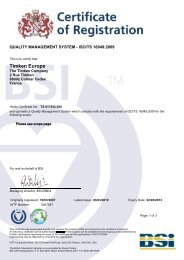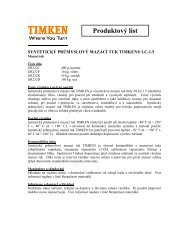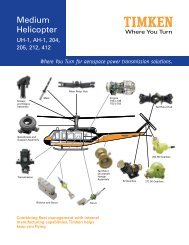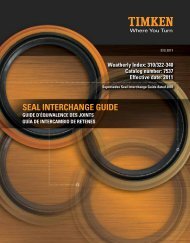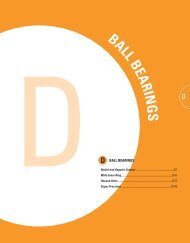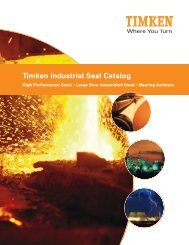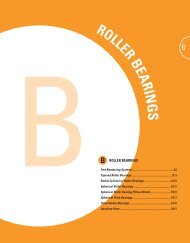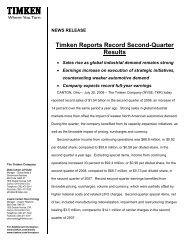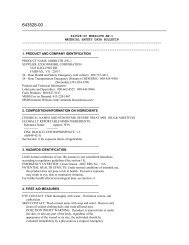Technical Paper - Timken
Technical Paper - Timken
Technical Paper - Timken
You also want an ePaper? Increase the reach of your titles
YUMPU automatically turns print PDFs into web optimized ePapers that Google loves.
Flexible pins have been designed into various types<br />
of equipment and the designs have typically included as-<br />
sembly of separable components including gears, pins,<br />
mounting sleeves, backing plates, capscrews and various<br />
type of rolling element bearing races and bushings. See<br />
Fig. 4 for a typical mounting arrangement.<br />
FIGURE 4 – TYPICAL FLEXIBLE PIN DESIGN<br />
Such a design achieves the objective of creating a<br />
torsionally compliant system as illustrated in Fig. 5. Ad-<br />
ditionally, since gears are less prone to be tipped off axis<br />
because the single sided planetary carrier can no longer<br />
wind up, it can be argued that gear contacts have a much<br />
higher probability of remaining centered at all meshes. It<br />
follows then that the flexible pin permits the designer to<br />
specify narrower gears and still avoid stress concentra-<br />
tions at the edges of the face. Power density is therefore<br />
improved in the axial direction.<br />
FIGURE 5 – COMPLIANT PLANET CARRIER SYSTEM USING FLEX-<br />
IBLE PINS<br />
A substantial improvement can be realized if one<br />
takes advantage of modern bearing technology and ad-<br />
vances the entire design to the next level, which is full in-<br />
tegration of the gear with the outer races of the bearings,<br />
and full integration of the sleeve with the inner races of<br />
the bearings. This advancement is the Integrated Flex-<br />
pin Bearing (IFB) and is illustrated in Fig. 6. This novel ap-<br />
proach to design and construction of the flexible pin ar-<br />
rangement provides increased opportunity to add power<br />
density to an epicyclical gear drive in the axial and radial<br />
directions. The beam strength of the sleeve and gear are<br />
both increased from the integration of the bearing com-<br />
ponents allowing for downsizing especially in the radial<br />
direction.<br />
FIGURE 6 – CROSS-SECTIONAL VIEW OF THE IFB<br />
Other features of the IFB include:<br />
(1) Elimination of sub-assembling the flexible pin arrange-<br />
ment<br />
(2) Elimination of many components for weight savings<br />
and cost reduction<br />
(3) There are no tight-fitted outer races that can still pre-<br />
cess inside the gear creating wear, debris and extra bear-<br />
ing clearance



